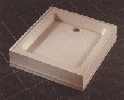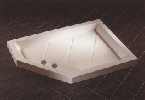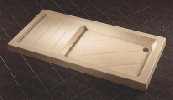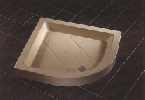Shower Tray
Shower trays are used in conjunction with a shower enclosure although they can be used (less satisfactorily) with a shower curtain
There are a number of different shapes available and quite a few different materials.
|
|
|
|
|
|
Each of these shapes is offered in several different sizes depending on the manufacturer.
Small shower trays 700x700mm are readily available , but they do not offer much room to shower and should only be installed if you have no other option. Most shower tray manufacturers make large shower trays with 1200x900mm being a typical maximum size. There are some available even larger but these tend to be special order only.
If you want a very large area in which to shower you could consider installing a wet room, where the whole of the floor acts as one big shower tray.
Available space will be the main factor in determining your choice of shower tray. When choosing a shower tray the general rule is to opt for as large a cubicle as possible, although the shape can also be important.
A shower tray is not always made by the same manufacturer as the shower cubicle, so care must be taken to ensure that the products chosen are compatible. This is especially important with quadrant shower cubicles as the radius of the curved section can vary, so always buy this type of cubicle and tray from the same source.
Shower Tray Materials
The majority of shower trays sold in the UK are now of the resin bonded stone variety.
Stone resin shower trays are available with a flat base suitable for installation on a solid floor with the pipework being run below the floor level. However, some are also now available with adjustable legs and detachable panels enabling the waste pipe to be run above the floor and allowing access to the shower trap. The main disadvantage of stone resin shower trays is that the gel coat used to produce the glossy surface is softer than other materials and can lose its sheen over a period of time. To address this problem some manufacturers now offer stone resin trays that are capped with an acrylic layer rather than a gel coat.
Acrylic trays are made in the same way as acrylic baths and are reinforced by a solid baseboard with adjustable legs, enabling pipework to be run above floor level. When acrylic trays first appeared in the 70's they had no reinforcing and acted like trampolines before eventually cracking! The finish on acrylic trays should outlast stone resin trays but they are generally more expensive.
Shower trays can also be made from enamelled steel, ceramic and even natural stone such as limestone. These are not very common in the UK and as a consequence are expensive by comparison.
Shower Tray Upstands
Some shower trays are available with "upstands" on two three or four sides. These upstands ensure a watertight finish is produced when fitting ceramic wall tiles or a shower wall panel. Upstand trays require the walls to be true and square to avoid the tiles protruding.
Shower Tray Colours
Most trays are available in white, pergamon, and soft cream. Standard stone resin trays can still be obtained in many of the older or "discontinued" colours i.e. burgundy, avocado, champagne, sun king, pampas, coral pink, turquoise, primrose, sky blue. There are more details on shower tray colours - here.





